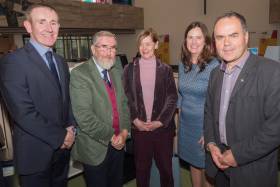Displaying items by tag: Ernest Shackleton
The board of a famed Oslo Museum met for the first time outside Norway in Athy as part of this year's Ernest Shackleton Autumn School over the October Bank Holiday. Directors of The Fram Museum, which tells the story of polar exploration, attended the 18th annual School at the Athy Heritage Centre Museum.
The Autumn School, which was opened by the Norwegian Ambassador to Ireland, Her Excellency, Else Berit Eikeland, commemorates the achievements of Kilkea-born 20th century explorer Shackleton. Shackleton’s 1914-16 Endurance Expedition to the Antarctic is regarded as one of the epic stories of human survival.
The Ernest Shackleton Autumn School is a project of Athy Heritage Centre Museum, supported by Kildare Failte and Kildare County Council.
"We hope the experiences of the board of the famous Fram Museum will serve as a calling card for Kildare," said Aine Mangan, CEO, Kildare Failte.
"We are very conscious of the role that the memory and achievements of Ernest Shackleton can play in developing the visitor offering in Kildare."
"Also, our county offers wonderful opportunities for corporate gatherings such as these, and we hope that this event will further build on Kildare’s relationship with the Fram Museum."
"We are grateful that the Board of the Fram Museum travelled to spend time commemorating Shackleton and exploring and enjoying a wealth of Kildare experiences."
Locally, the Council is supporting redevelopment plans for a new Shackleton Polar theme museum in the former Town Hall building in Athy’s historic Emily Square.
PHOTOS
2822—
2830— Seamus Taaffe (standing on the left) of the Board of Directors, Athy Heritage Centre, with the Board of Directors group from the Fram Museum (Oslo) who held their Annual Board Meeting in Athy.
Podcast: Shackleton, Blue Economy & Open Sea Swimming
Hello and welcome aboard your maritime programme Seascapes, this week we bring you highlights from the unveiling of a fine sculture by Mark Richards in Athy, Co Kildare on the centenary to the day of the rescue of the Endurance crew from Elephant Island and the unveiling of a sculpture by Mark Richards of Sir Ernest Shackleton beside the Athy Heritage Centre in his home place complete with an Honour Guard from the Irish Naval Service, we’ll be talking to Kevin Kenny of Athy Heritage Centre ; Commander Cormac Rynne of the Irish Naval Service; Arts Officer Lucina Russell and Jack L who performed “The Wearin’ of the Green” and we also met up with Jonathan Shackleton ...... also this week Dr Gordon Dalton of MAREI on the Maribe project and the outcome of a recent conference held in Cork....first this week here on Seascapes to our Galway Studios where we can hear from Features Editor Gery Flynn of Inshore Ireland Magazine on what’s in the latest edition ...
Features Editor of Inshore Ireland magazine – Gery Flynn ....next here on Seascapes to Athy in Co Kildare where .............to coincide with the very day a hundred years ago on the 30th of August that epic rescue of The crew of The Endurance from Elephant Island was marked by a sculpture by Mark Richards being unveiled by the Mayor of Kildare , Cllr Ivan Keatley and Alexandra Shackleton with an honour guard drawn from the Irish Naval Service in attendance ....
Also present for the ceremony was local musician Jack L who spoke briefly to Seascapes before he performed this song...
Jack Lukeman performing The Wearin’ of the Green” next we spoke to Jonathan Shackleton ...
Also in attendance was Commander Cormac Rynne of the Irish Naval Service.....
From Commander Cormac RYNNE to Kildare Arts Officer , Lucina RUSSELL..
The Athy Heritage Centre is in the heart of the town and is hosting an exhibition “ By Endurance We Conquer “running until February of next year....
Lets have a final word from Kevin Kenny of Athy Heritage Centre....
MARIBE is Marine Investment for the Blue Economy , Dr Gordon Dalton who is based at MaREI ERI, at University College Cork is Maribe Project Coordinator , we last talked to him earlier this year
Dr Gordon Dalton of MAREI /ERI – Maribe Project Coordinator
We wish swimmers the “Swim Sisters” team of Lynsey Dunne -Connacht, Mary Bolger-Hinds- Leinster, Claudine Hughes -Ulster and Maighread McMahon from Munster , they will attempt to become the first four provinces, all-female team to swim the length of the largest freshwater lake in these islands , Lough Neagh – a distance of approximately 30.5km.
The “Swim Sisters “ are four experienced open water swimmers and members of the Irish Long Distance Swimming Association. And it was through their love of open water swimming that the team the " Swim Sisters " came together. Two of them , Lynsey & Maighread are veterans of two successful English Channel relay swims.You can read more about their swim on the Seascapes webpage....
That’s it for this week on your maritime programme, on the sound desk this week Niall O Sullivan , next week here on Seascapes we bring you the story of the Aud and Sir Roger Casement and highlights from the commemoration held on Banna Strand earlier this year at Easter .....Grainne McPolin was there for Seascapes when she spoke with with H.E. President Michael D Higgins we hear from local historian Pat Lawlor about Sir Roger Casement the humanitarian, explorer and seafarer and descendants of Captain Monteith and Sir Roger Casement ; until next Friday night, tight lines and fair sailing.”
A popular wedding venue a Wedding Fair is being held in The National Maritime Museum of Ireland, Haigh Terrace, Dun Laoghaire on Sunday 18th September open from 12 noon....
Ireland’s National Maritime Museum is housed in Dun Laoghaire’s 180-year-old Mariners Church, directly opposite the new DLR Lexicon library and easily accessible by DART suburban train and several bus services. The museum’s greatest artefact is probably the building itself as it is one of a few custom built places of worship for seafarers remaining intact in the world to-day.
Experienced guides will bring you on a voyage of discovery enthralling you with stories of discovery, heroism, war and disasters at sea. You will learn about maritime history, exploration, navigation, radio, deep-sea cable technology, nature, wildlife and view art inspired by the sea.
See the 10-tonne revolving Baily Optic, try the electrified steam engine and pause to reflect at the Titanic exhibit, the re-created radio room, the Royal Navy prisoners docks and the war memorial. Try sailor’s knots, learn how they lift heavy weights, be photographed with the pirate, research in the library, visit the shop and café and much more.
Shackleton's Cabin Restored In Connemara As Irish Woman Retraces Adventurer's Route
#Shackleton - As Shackleton's cabin arrives in Connemara for restoration, an intrepid young Irish woman is setting out to retrace the pioneering explorer's Antarctic footsteps.
According to The Irish Times, the 'sea bedroom' where Ernest Shackleton died of a heart attack in 1922 has been relocated to Conservation Letterfrack by its Norwegian owner for an array of restoration works before its transfer to the Athy Heritage-Centre Museum, in the explorer's county of birth, in the new year.
Originally part of the Norwegian steamship Quest, purchased by Shackleton for his final Antarctic voyage, the cabin was removed from the vessel at some point before the ship sank during a seal hunt in 1962, and wound up at a farm in Norway’s Nordland region, where present owner Ulfe Bakke played in it in his childhood.
Bakke has now donated the cabin to join a permanent exhibition in tribute to Shackleton's endeavours, including an original ice sledge and writings from his missions.
As previously reported on Afloat.ie, Shackleton's final resting place on South Georgia Island can be visited virtually via Google Street View.
Meanwhile, Irish Army Lieutenant Sinéad Hunt is entering her last fortnight of training before she embarks on a two-week trek across the Antarctic to mark the centenary of Shackleton's 1915 expedition, as TheJournal.ie reports.
The Dubliner will join New Zealand adventurers Tom McTavish and James Blake on the trip that will take them from the Falklands to South Georgia, following the arduous journey made by Shackleton, Tom Crean and four others after they abandoned the Endurance in pack ice.
To prepare for the challenge, the experienced climber and Alpine skier has been training in the Wicklow Mountains – but the severe storms and blizzards at the end of the world might prove a different prospect.
Shackleton's Island Resting Place Now On Google Street View
#Shackleton - When famed Irish explorers Ernest Shackleton and Tom Crean set foot on the island of South Georgia in 1916, it was as remote as one could get in the world at that time.
Fast forward to 2014 and the vistas of that Southern Ocean outcrop are available to all, thanks to an intrepid hiker equipped with Google's Trekker backpack camera.
As TheJournal.ie reports, Linbald Expeditions and National Geographic sent one of their videographers with the special 360-degree camera unit to capture images for the Google Street View virtual mapping service.
And the fruits of that adventure are some 10,000 shots taken across nine locations, roughly plotting the path that Shackleton and his crew took on their pioneering Endurance voyage - and their epic journey to seek rescue when the ship was trapped in ice.
Crean and four others joined Shackleton to set out across 1,300km of open ocean from Elephant Island on the edge of the Antarctic to South Georgia, where they were the first known to traverse its hostile landscape to reach the help they needed.
Even today that land is rarely visited, with a population of just 30 or so - mostly scientists and staff of the British Antarctic Survey.
But now anyone in the world can have a glimpse of its rugged natural beauty, from the penguins of Right Whale Bay to Shackleton's final resting place.
TheJournal.ie has much more on the story HERE.
Shackleton: A Century Apart
Writers, musicians and actors will be joined by relatives of Shackleton for an evening of theatre, illustrated talks, newspaper readings, poetry and song in the splendid interior surroundings of the city-centre venue (click here).
Tickets for the evening event on Monday 21 February, starting at 6.30pm, cost €10 at the door or can be purchased in advance by contacting (01) 872 2377. The event will be repeated in the Droichead Arts Centre, Drogheda on Monday 28 February, at 8pm. For further details Tel: (041) 983 3946
Shackleton Exhibition's Photo ‘Polar’ Prize
To celebrate the achievements of Shackleton and Hurley's stunning photographic collection, the (MMM) want you to share your photos of spectacular scenery, unusual locations and far-flung destinations. Just add them to the Flickr group to be in a chance of a family concert ticket for the Royal Liverpool Philharmonic's unique combined film and music experience 'Polar'.
The cinematic portrait of the Arctic and Antarctic explores the homeland of the polar bears and humpback whales. The moving imagery will be accompanied by a live orchestral soundtrack performed by the world-renowned orchestra.
For further detailed information about the competition and entry rules logon HERE.
The Endurance: Shackleton's Antarctic Adventure at the Merseyside Maritime Museum is open to the public free of charge until the 27 February 2011. For more info logon HERE
































































